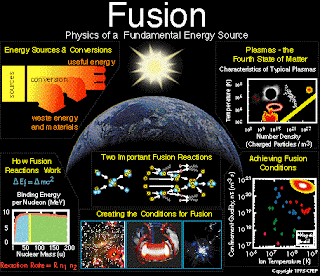 |
| Image Source: Binus University Research Interest Group |
Topics: Alternative Energy, Nuclear Fusion, Nuclear Physics, Nuclear Power
Abstract
This article is an editorial, which makes the case that fusion breeding (that is using fusion neutrons to breed nuclear fuel for use in conventional nuclear reactors) is the best objective for the fusion program. To make the case, it reviews a great deal of plasma physics and fusion data. Fusion breeding could potentially play a key role in delivering large-scale sustainable carbon-free commercial power by mid-century. There is almost no chance that pure fusion can do that. The leading magnetic fusion concept, the tokamak, is subject to well-known constraints, which we have called conservative design rules, and review in this paper. These constraints will very likely prevent tokamaks from ever delivering economical pure fusion. Inertial fusion, in pure fusion mode, may ultimately be able to deliver commercial power, but the failure to date of the leading inertial fusion experiment, the National Ignition Campaign, shows that there are still large gaps in our understanding of laser fusion. Fusion breeding, based on either magnetic fusion or inertial fusion, greatly relaxes the requirements on the fusion reactor. It is also a much better fit to today’s and tomorrow’s nuclear infrastructure than is its competitor, fission breeding. This article also shows that the proposed fusion and fission infrastructure, ‘The Energy Park’, reviewed here, is sustainable, economically and environmentally sound, and poses little or no proliferation risk.
Introduction
The fusion program, both short term and long term, is in trouble, certainly in the United States, and likely worldwide. In addition to large cost overruns and failures to meet milestones, surely another reason is that pure fusion has almost no chance of meeting energy requirements on a time scale that anyone alive today can relate to. Hence the assertion of this article is that fusion breeding of conventional nuclear fuel is a likely way out of fusion’s current and future difficulties. Fusion breeding substantially reduces the requirements on the fusion reactor. It significantly reduces the necessary Q (fusion power divided by input power), wall loading, and availability fraction. The capital cost of a reactor, estimated based on ITER’s capital cost, is affordable for fusion breeding, but definitely is not for pure fusion. It is likely that fusion breeding can produce fuel at a reasonable cost by mid century. The entire fusion and fission infrastructure would be sustainable, economical, environmentally sound, and have little or no proliferation risk. This article’s mission then, is to hopefully convince a much larger portion of the fusion establishment to make this case. At the very least it hopes to broaden the discussion in the fusion community from where we are now, where one prestigious review committee after another insists that every existing project is absolutely vital, nothing can be changed; except give us more $$$. The inevitable result of this process is that one fusion project after another gets knocked off.
RD Springer: Fusion Breeding for Mid-Century Sustainable Power, Wallace Manheimer
Comments